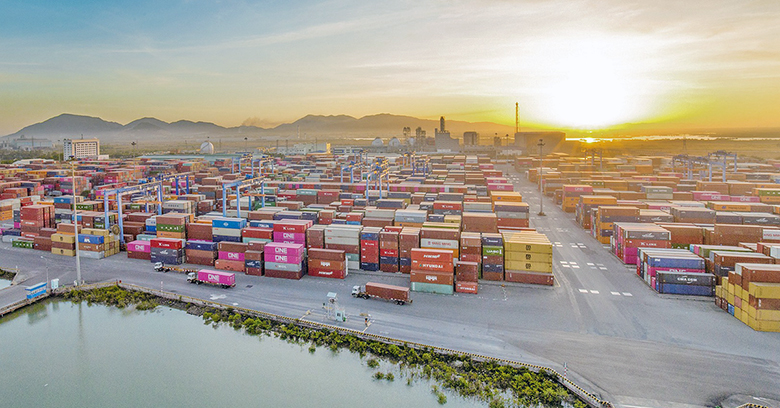
After ten years of work between the EU and Vietnam, the Free Trade Agreement (FTA) and Investment Protection Agreement (IPA) have been voted in favor by the European Parliament. Once the FTA comes into force, which is expected to happen in July 2020, it will phase out 99% of tariff and trade barriers between the EU and Vietnam.
On the 12th of February, in Strasbourg, the European Parliament voted in favor for the FTA and IPA with Vietnam. The last step for the FTA is the approval by the National Assembly of Vietnam, who are taking a vote in May 2020. If approved, which is expected, the implementation will start from July 2020. However, the IPA needs ratification by each of the EU’s Member States before coming in to force.
The European Parliament’s vote in February is the result of the 10-year ongoing negotiations between the EU and Vietnam. It is a historic event that will start a new chapter of the relation between the two parties. The voted FTA is the most ambitious agreement between EU and a developing country yet.
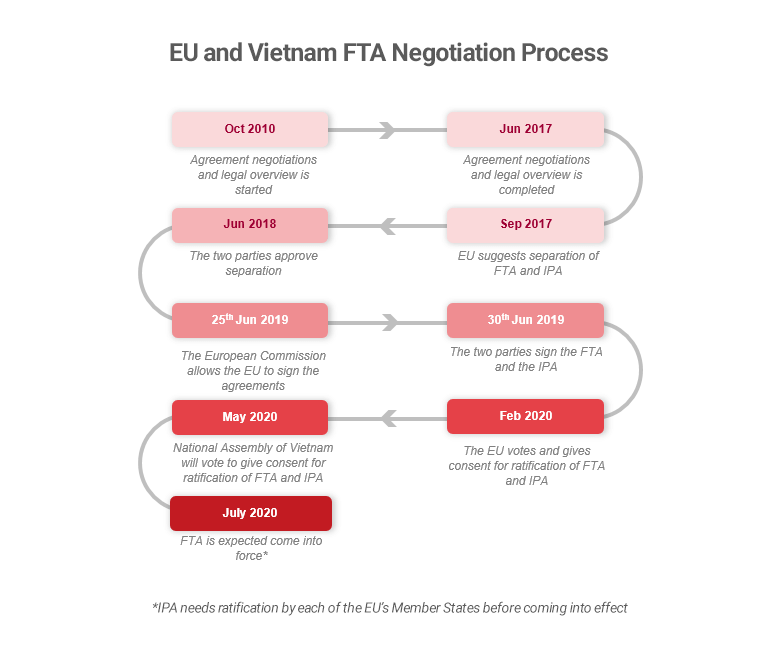
In 2018, the EU was the second-biggest export market for Vietnam, only falling behind the US. However, compared to EU’s total imports in 2018, Vietnam’s share only constituted 1.93%. On the other hand, the share of exports to Vietnam from the EU accounted for 5.87% during 2018. With the FTA in place, the trade flow between the two parties is expected to increase significantly.
The agreement includes extensive commitments on the reduction of tariffs, phasing out over 99% of custom duties on exports in both directions. Moreover, the FTA also includes commitments to reduce non-tariff barriers. For example, Vietnam will align more closely with international standards on motor vehicles and pharmaceuticals. As a result, EU products (which already complies with these standards) will not require any additional testing and certification procedures in Vietnam. The agreement will also enable EU- based companies to compete for Vietnamese government contracts (and vice-versa) and make it easier for these companies to operate in the Vietnamese postal, banking, insurance, environmental and other service sectors. It also includes commitments to implement International Labor Organization core standards, such as freedom to join independent trade unions, which currently do not exist in Vietnam, and UN conventions, such as combatting climate change and protecting biodiversity.
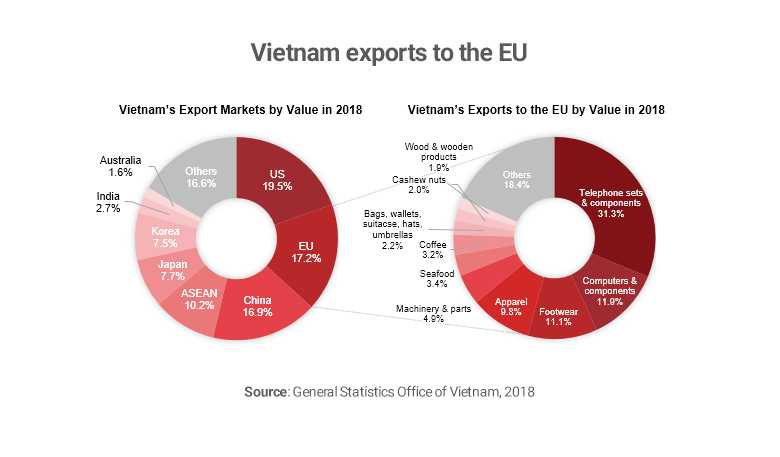
Once the EVFTA comes into effect, 71% of EU duties on Vietnamese imports will immediately be abolished, while the remaining tariffs is projected to be eliminated within a seven-year period. To present the tariff rates changes, export values of the products in each of the top export categories from Vietnam to the EU are weighed in relationship with their corresponding tariff rates.
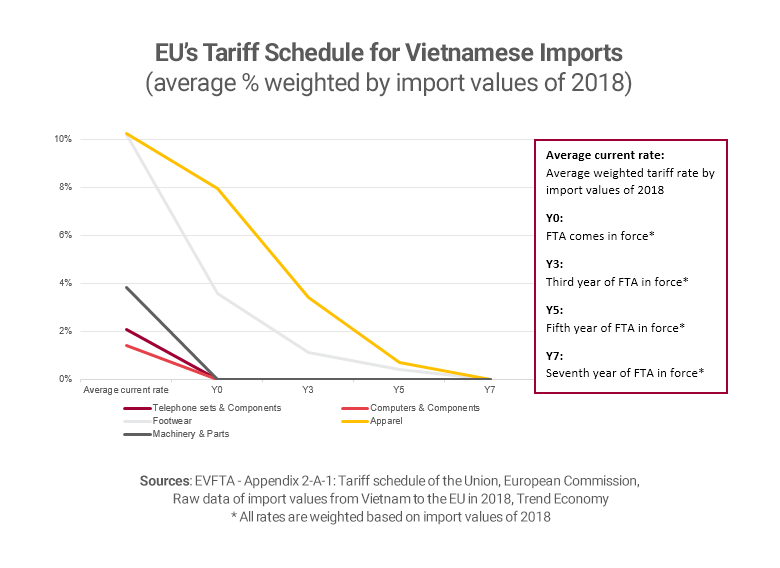
The current tariff rates of some Vietnamese imports to EU, for example ‘Telephone sets & Components’, are comparatively low and will be phased out completely on the first year of implementation. The current levies on ‘Apparel’ and ‘Footwear’, on the other hand, are fairly high and will take seven years to be entirely phased out. However, since most countries exporting apparel and footwear to the EU does not have an FTA in place, the EVFTA is believed to bring massive growth to these sectors. It’s also worth noting that Vietnam’s footwear and apparel products can only enjoy the preferential tariffs if they meet the product’s rules of origin stated in the agreement. In order to do that, Vietnam will need to put more focus on developing support industries to meet its demands for production materials.
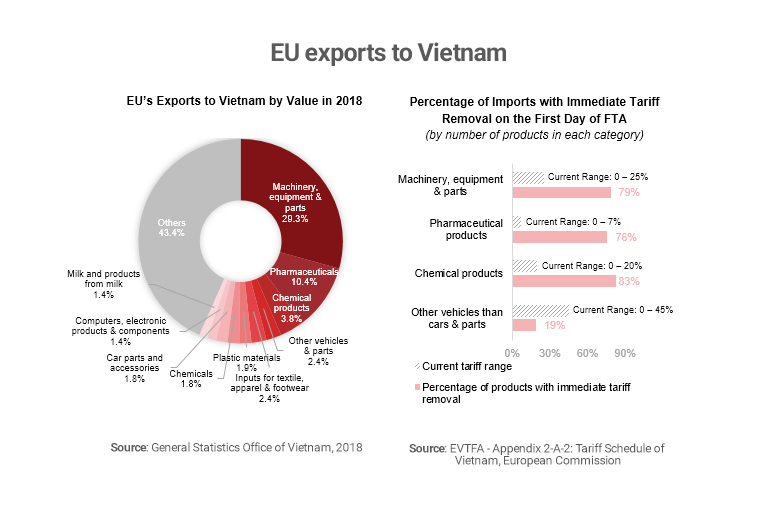
Vietnam commits to eliminate 65% of the tariffs on imports from EU right away, with the rest being phased out over a decade of implementation.
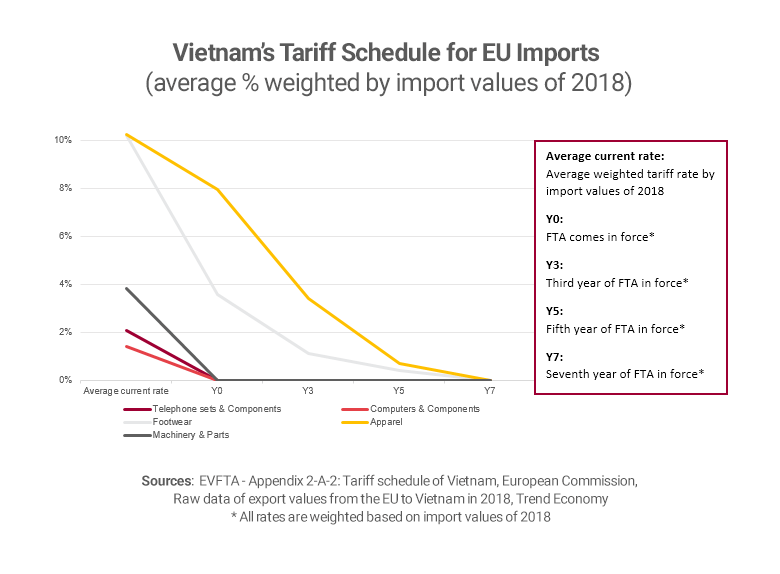
Among the top EU exports to Vietnam, ‘Machinery, equipment, & other components’ will be completely duty-free after seven years, which is also the case for pharmaceutical products. Most of ‘Chemical products’ will be duty-free immediately or within three years after the FTA comes in force. The remaining will be liberalized during the ten-year implementation period. EU’s export of aircrafts to Vietnam contributes to a large proportion of ‘Other vehicles & parts’, and it is currently free of duties. For that reason, the category has a low average current tariff rate. However, other vehicles such as bicycles and their parts are under duties up to 45%. The trade pact will remove these customs over the ten-year period.
In conclusion, the EVFTA is believed to bring big opportunities and enhance the trade between the two parties, by abolishing 99% of all tariffs between the countries over a ten-year period. Furthermore, the FTA also contains commitments to lower non-tariff barriers, such as aligning Vietnamese manufacturing to international standards and allowing European companies to compete for Vietnamese government contracts (and vice-versa). The agreement is historical as it is a first of its kind, being an FTA between the EU and a developing country.
Read more about our consulting services.
The insights provided in this article are for general informational purposes only and do not constitute financial advice. We do not warrant the reliability, suitability, or correctness of the content. Readers are advised to conduct independent research and consult with a qualified financial advisor before making any investment decisions. Investing in financial markets carries risks, including the risk of loss of principal. Past performance does not guarantee future results.
The views expressed herein are those of the author(s) and do not necessarily reflect the company's official policy. We disclaim any liability for any loss or damage arising from the use of or reliance on this article or its content. ARC Group relies on reliable sources, data, and individuals for its analysis, but accuracy cannot be guaranteed. Forward-looking information is based on subjective judgments about the future and should be used cautiously. We cannot guarantee the fulfillment of forecasts and forward-looking estimates. Any investment decisions based on our information should be independently made by the investor.
Readers are encouraged to assess their financial situation, risk tolerance, and investment objectives before making any financial decisions, seeking professional advice as needed.



